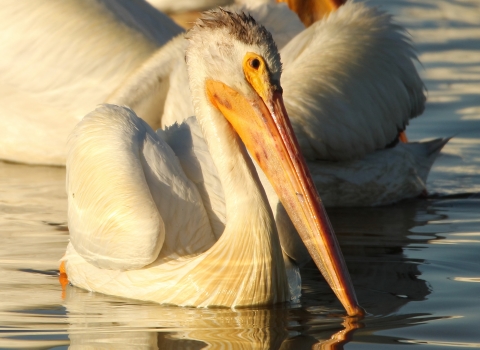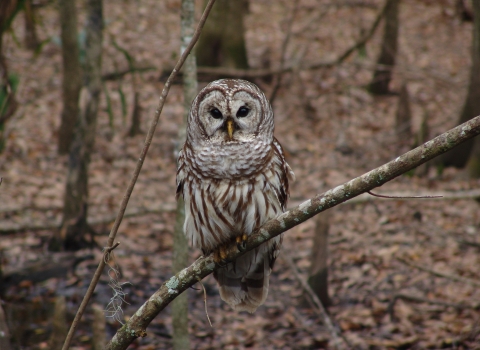“A child’s world is fresh and new and beautiful, full of wonder and excitement. It is our misfortune that for most of us that clear-eyed vision, that true instinct for what is beautiful and awe-inspiring, is dimmed and even lost before we reach adulthood.” Rachel Carson, The Sense of Wonder
When you hear the word “classroom,” what image comes to mind? Is it a room lined with rows of desks, posters of famous authors on the walls and a chalkboard at the center of the room? What sounds would you expect to hear? Perhaps the shuffling of books and papers, the bell signaling it’s time to change classes, or announcements blaring from the intercom? Now what if this classroom was an open forest, and instead of rows of desks, trees and lush plant life surrounded you? There are no posters or chalkboards, and the only sounds you’ll hear are of a stream flowing, the shuffling of earth beneath your feet or of birds singing a beautiful melody. The lessons learned in this classroom are the ones that have been taught since the dawn of time –the delicate balance of nature, connecting us with everything living thing. These are the lessons Amanda Wilkinson, Public Use Specialist for the U.S. Fish and Wild Service’s South Arkansas Refuge Complex, is instilling in 13 preschoolers with developmental delays through a program she created known as “Refuge Therapy.”
The goal of the program is to introduce children to nature while helping them to grow both mentally and socially in the process. All of the participants are students at the Carousel School, whose mission includes to “strive to effectively transition developmentally delayed children into a regular kindergarten classroom setting with positive expectations.”
Refuge Therapy was first conceived when the school called the refuge to schedule a summer field trip. Upon arrival, some of the children were apprehensive; some were highly anxious and some were very introverted. The trip began with a tour of the Visitor Center, allowing the children to explore and learn about the refuge. “Because of the kids’ anxiety, it was clear that every child could use a hand to hold for the remainder of the trip,” said Wilkinson. Their tour of the refuge ended with a nature walk along a short trail behind the Visitor Center. Here, the children were encouraged to touch the bark of the trees, pick up leaves and gum balls, look out over the pier at the pond, and smell the wildflowers growing in the butterfly garden. Some of the children did, but most did not. “The hurdles for them were getting off the paved trail, touching the dirt covered objects, trusting the pier to take a glance, or trusting that the dragonflies that hovered over the garden were harmless,” said Wilkinson. “At that point, I realized that many of these kids never had an outdoor experience like this. I felt compelled to offer more trips, to encourage the connection with nature and fill them with positive reinforcement when came to the natural world.”
That summer proceeded with four additional refuge field trips. Each time the children took nature walks along the same trail, and with Amanda’s guidance, focused on different hurdles and elements to conquer. “We fished in the pond from the very pier that only two months prior some of the kids would not go on. We fished with live crickets!” said Wilkinson.
Those initial field trips have led to Refuge Therapy being a year-round program that couples early childhood fundamentals with the natural world. Monthly visits, bringing nature to the classroom and summer field trips are now the components of the program. There is even an “outdoor corner” in the classroom, which consists of a huge paper tree, a nature banner made during the first visit to the refuge, and a touch table that allows them engage with nature while they’re indoors. With each lesson Amanda adds pieces to the outdoor corner, changing the leaves on the tree depending on the season and laying out “nature spots.” “Nature spots are a laminated picture of the earth. Once they sit, I ask them to hand me their earth and tell me something they saw, heard, touched, smelled or tasted in nature that week. I then go into the lesson for the month,” explained Wilkinson.
Thanks to willingness of the Carousel School to pilot this experience, Refuge Therapy has given these children a new way to look at the world around them. “From the very first time until now, I’ve noticed the increased awareness the kids have gained for the world around them,” said Wilkinson. “They are stopping to hear the birds sing, asking about various plants and flowers they find, and are excited to talk about it all during my next visit. The word “nature” is now a part of their vocabulary, and they are constantly connecting it to all things.” The children’s teacher, Mrs. Shalanda, has also noticed positive changes since the beginning of the program. “Wow, the changes are so dramatic. We collect leaves now, to place in our touch center. We are so amazed at the change in our students’ ability to adapt to the feel of objects in nature, and that they are open to experience the environment surrounding us each day.”
Perhaps one of the most noticeable developments has been in a little girl named Caelynn, who at the start of Refuge Therapy was terrified to be outside and overwhelmed during the first visit. However, by the end of the summer she held a bucket full of live crickets, and she didn’t stop there. Caelynn is now excited to participate in regular nature walks with her class and finding new things to discover.
It’s not just the children who have been impacted by the program. “As a mother myself, to two small children, I find it fascinating that their minds are like little sponges, soaking in everything around them, just waiting for the opportunity to use their knowledge. For me it has been an awesome experience to not only introduce nature to these children, but to be there during such an instrumental time in their lives,” said Wilkinson.


